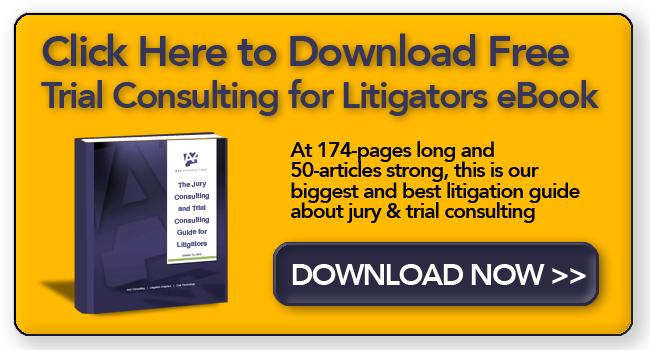 by Ken Lopez
by Ken Lopez
Founder/CEO
A2L Consulting
This is Part 3 of a four-part series on the rise of the midsized law firm in litigation. Parts 1,2,3,4.
$10 billion in legal fees spent by outside counsel over a recent three-year period were analyzed by Lexis-Nexis. For litigation matters where at least $1 million was spent, it was discovered that law firms with 201-500 lawyers (midsized law firms) increased their market share from 22% to 41% while firms with 750 or more lawyers (large law firms) saw their share fall from 26% to 20% over the three-year period. This shift represents one of the biggest changes in the history of law firms and makes obvious that the rise of midsized law firms is underway in high-stakes litigation.
In the previous two articles in this series, I talked about what midsized law firms need to know about using litigation graphics and trial technicians/trial technology. Here, I wish to discuss how a litigator from a midsized firm can use trial research, commonly called trial consulting, jury consulting or even litigation consulting.
For the most part, I think mid-sized law firms have made good use of mock exercises, even though they use them a bit differently than large law firms use them in large cases. If midsized firms are to find success in large cases and save money for their clients through lower fees, they will have to prove themselves.
One of the easiest and most logical ways to ensure success is to model it and test it, and that's what trial consulting or jury consulting is -- a platform for seeing what works and what does not. Surprises occur in every exercise -- although there are some common things all mock juries say.
1. One Size Does Not Fit All: Just as both a midsized firm and a large firm can try a case, not every large case needs a large exercise. It's not all or nothing. One mock jury panel is not usually enough, but four jury panels over multiple exercises with retired federal judges observing does not suit most cases either. These days, good trial consultants build an exercise to suit the case. See our Micro-Mock service for example.
2. Corporate Clients Still Expect Large Law Firm Results: Great results are often the result of a great trial team that has extensively tested a case through research and adapted to those results. If your clients expect great results, explain that research is not an area to cut back on. Research, like other litigation consulting services, is really a drop in the bucket of the overall litigation budget and the ROI is very high.
3. Research is a Money Saver Not a Money Spender: You can cut more than you think in most cases. Trial consulting is one of the best ways to find out where. Often themes, experts, and litigation graphics can all be trimmed as a result of conducting good research.
4. Local is not critical: Can you try cases effectively only in your back yard? Of course not. The same is true for a good trial consultant. Don't skimp on quality just because you think there is some magic local understanding that the researcher must have. Remember, the research is conducted on local people and that is where the answers come from, not the researcher.
5. Your administrative staff is not a good barometer: It is well known that running a case by your admin staff or family is not a good use of time. You are not going to get the outside feedback that you need.
6. Nothing is more expensive than a cheap lawyer or trial consultant: Pay less, get less. Everybody is willing to reduce price these days, so you really need to distinguish based on quality and experience more than ever before.
7. Have your client see you perform: Since in-house counsel is still, on some level, trying to justify the choice of a midsized firm, it is a good idea to let them see you perform a bit. However, you might not want to use stage one of the exercise for this purpose because you'll look better in front of the client after some practice.
8. The Difference Between Small Cases and Big Cases is Really Big: One panel of jurors is not really research. There is not enough data to draw meaningful conclusions. Unfortunately, many midsized firms are used to a one-panel approach. In big cases (really all cases), two to four panels work but only one does not.
9. Longer is not usually better: Sometimes, counsel wants to schedule multiple days for a mock, and it is usually unnecessary. It is better to say less and gather more reactions than to schedule more detailed and longer presentations.
10. Test graphics: Today, graphics are an essential component of a mock exercise.
11. Use technology: Practicing with your trial technician is often a good idea during the mock.
12. Most midsized firms are not used to using outside sources for witness preparation: Deposition may be the only testimony their experts give in most cases. However, there is little preparation of key witnesses just before the deposition. As a result, the witness can easily be tripped up. Preparation is the key. See Witness Preparation: Hit or Myth?
13. Investing time in voir dire. Don't rely on your tried and true approach. The questions that are submitted should be highly customized. Our five-part series on voir dire should be helpful. It begins with Jury Selection and Voir Dire: Don't Ask, Don't Know.
14. Jury questionnaires should be one result of a mock exercise wherever possible: They should be the result of an mock exercise, not something that is done by gut instinct. 10 Signs of a Good Jury Questionnaire.
15. Use mock exercises as development tools: One thing that has led to good results is experience litigating a case to verdict. Yes, experience matters. But, as fewer cases go to trial, getting that experience is largely being relegated to mock exercise rooms.
16. Budget: Rather than ask for a budget and try to get a deal, present what you have and ask your jury consultant to give you a solution.
17. Mocks are Being Used in Surprising Places: We wrote an article that might surprise even a veteran litigator: 11 Surprising Areas Where We Are Using Mock Exercises and Testing.
Parts 1,2,3,4.






Leave a Comment